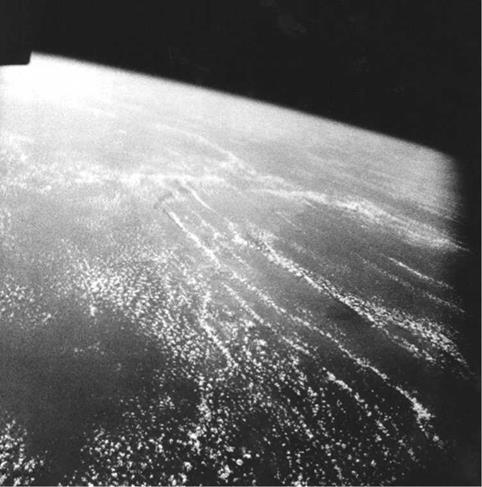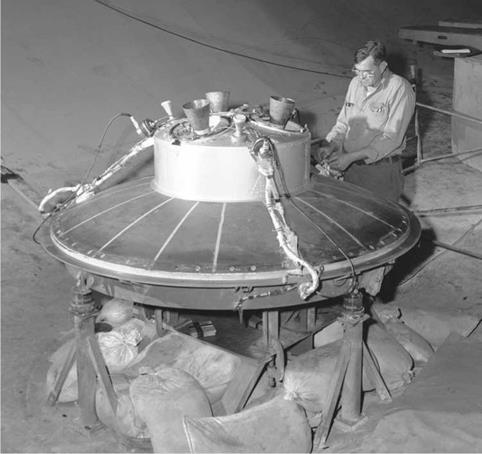THE VIEW FROM SPACE
In the book, We Seven, Shepard related his observations of the planet passing below:
My exclamation back to Deke about the “beautiful sight” was completely spontaneous. It was breath-taking. To the south I could see where the cloud
|
One of a small number of Earth observation photos taken by Shepard during his brief flight. (Photo: NASA) |
cover stopped at about Fort Lauderdale, and that the weather was clear all the way down past the Florida Keys. To the north I could see up the coast of the Carolinas to where the clouds just obscured Cape Hatteras. Across Florida to the west I could spot Lake Okeechobee, Tampa Bay, and even Pensacola. Because there were some scattered clouds far beneath me I was not able to see some of the Bahama Islands that I had been briefed to look for. So I shifted to an open area and identified Andros Island and Bimini. The colors around these ocean islands were brilliantly clear, and I could see sharp variations between the blue of blue water and the light green of the shoal areas near the reefs. It was really stunning.
But I did not just admire the view. I found that I could actually use it to help keep the capsule in the proper attitude. By looking through the periscope and
focusing down on Cape Canaveral as the zero reference point for the yaw control axis, I discovered that this system would provide a fine backup in case the instruments and the autopilot happened to go out together on some future flight.
It was good to know that we could count on handling the capsule this extra way – provided, of course, that we had a clear view and knew exactly what we were looking at. Fortunately, I could look back and see the Cape very clearly. It was a fine reference [15].
Years later, Wally Schirra told interviewer Francis French that Shepard’s remarks on his “beautiful view” were exaggerated due to his problems with the periscope. As Schirra explained, all the early astronauts felt they had some sort of obligation to say something nice about the view from space for public and press consumption. “It was just the game that people play. I’ll never forget alan Shepard, on the first manned American flight, saying something to the effect of ‘What a beautiful view.’ I asked him later, did you see anything at all? He said ‘I couldn’t see a damn thing through that periscope – but I had to say something nice!’” [16]
At 5 minutes 11 seconds into the flight, Freedom 7 reached the highest point of its ballistic arc at 115.696 miles. It now began its downward curve on a trajectory that was calculated to end with a splashdown somewhere near the naval recovery ships standing by in the waters near Grand Bahama Island, southeast of the Cape.
Deke Slayton began to recite the countdown for the retro-fire maneuver. Shepard used the manual control stick to point the spacecraft’s blunt end 34 degrees below the horizon in pitch and set both the yaw and roll angles to zero.
“I worked the controls to the proper angle to test fire the three retro rockets. They weren’t necessary for descent on this suborbital, up-and-down mission, but they had to be proven for orbital flights to follow, when they would be critical to decelerate Mercury spaceships from orbital speed to initiate their return to Earth.
“‘Retro one.’ The first rocket fired and shoved me back against my couch. ‘Very smooth.’ “‘Roger, roger,’ from Deke.
“‘Retro two.’ Another blast of fire, another shove.
“‘Retro three. All three retro have fired.’
“‘All fired on the button,’ Deke said with satisfaction.” [17]
Each retrorocket was to burn for approximately 10 seconds, and they were fired in sequence at five-second intervals. “There was just a small, upsetting motion as our speed was slowed and I was pushed back into the couch a bit. But, as the rockets fired in sequence, each pushing the capsule somewhat off its proper angle, I brought it back. Perhaps the most encouraging product of the trip was the way I was able to stay on top of the flight by using manual controls.” [18]
One minute after the last rocket fired, the package, its job done, blew off at T+6 minutes 14 seconds. Shepard felt the package jettison, and as he watched through the periscope he saw the straps that had held it in place begin to fall away. A green lamp was meant to illuminate on the instrument panel to indicate a successful jettison, but
|
As shown in this 1960 photo taken during testing at the Lewis Research Center, the spacecraft had a six-rocket retro-package affixed to the heat shield on its base. Three were posigrade rockets used to separate the capsule from the booster, and three were larger retrograde rockets to slow the capsule for reentry into the atmosphere. (Photo: NASA) |
it failed to come on – the only signal failure of the entire mission. Knowing that the package had jettisoned, Shepard punched an override button and the light instantly illuminated.
Shepard verified Freedom 7’s HF radio, and then at T+6 minutes 20 seconds he orientated the vehicle into the reentry attitude with its blunt end 40 degrees below the local horizontal. Twenty-four seconds later the periscope retracted automatically.
|
|
|
|
|
|
|
|
|
|
|
|
|
|
|
|
|
|
|
|
|
|
|
|
|
|
|
|
|
|
|
|
|
|
 |
|
|
|
|
|












